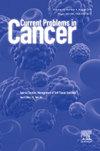MRI-fusion biopsy era: the role of perineural invasion in low-risk prostate cancer
IF 2.3
4区 医学
Q3 ONCOLOGY
引用次数: 0
Abstract
Objective
To evaluate whether perineural invasion independently predicts Gleason score upgrading during active surveillance in patients undergoing MRI-US fusion biopsy.
Patients and Methods
We retrospectively analyzed 325 patients initially diagnosed with Gleason Grade Group (GGG) 1 prostate cancer who underwent at least one subsequent biopsy. Demographics, imaging, and clinical variables were recorded. Univariate and multivariate logistic regression models assessed the association between perineural invasion and Gleason upgrading (GGG2+) on follow-up biopsy.
Results
Among 325 eligible patients diagnosed with GGG 1 prostate cancer on initial biopsy, 51 (15%) had perineural invasion, while 274 (84%) did not. Gleason upgrade occurred in 110 (34%) patients. Upgrading was observed in 24 of 51 patients (47%) with perineural invasion, compared to 86 of 274 patients (32%) without perineural invasion (p = 0.03). On univariate analysis, older age (OR 1.03; p=0.03), African American race (OR 2.22; p=0.04), number of positive cores (OR 1.13; p=0.007), and cancer detected on targeted biopsy (OR 2.26; p=0.01) were associated with upgrading. In multivariable analysis, perineural invasion (OR 1.84; p=0.1) was not independently associated with Gleason upgrading when adjusting for PI-RADS 4-5 (OR 1.98; p=0.01). However, cancer detected on targeted biopsy (OR 2.26; p = 0.01) and African American race (OR 3.2; p = 0.01) remained independently associated with upgrading.
Conclusions
In this contemporary series of patients managed with active surveillance in the era of MRI-ultrasound fusion biopsy, perineural invasion is not associated with Gleason upgrade on subsequent biopsy when adjusting for MRI- US fusion biopsy characteristics. Our findings highlight that a PI-RADS 4 or 5 lesion, and cancer found within an MRI-visible lesion are more predictive of subsequent progression in patients with GGG1 PCa.
mri融合活检时代:神经周围浸润在低危前列腺癌中的作用
目的评估在MRI-US融合活检患者主动监测期间,神经周围浸润是否能独立预测Gleason评分升高。患者和方法我们回顾性分析了325例最初诊断为Gleason Grade Group (GGG) 1型前列腺癌的患者,这些患者随后至少进行了一次活检。记录人口统计学、影像学和临床变量。单因素和多因素logistic回归模型评估了神经周围浸润与随访活检Gleason升级(GGG2+)之间的关系。结果在325例符合条件的初始活检诊断为ggg1前列腺癌的患者中,51例(15%)有神经周围浸润,274例(84%)没有。110例(34%)患者出现Gleason升级。51例有周围神经侵犯的患者中有24例(47%)出现升级,而274例无周围神经侵犯的患者中有86例(32%)出现升级(p = 0.03)。在单因素分析中,年龄较大(OR 1.03; p=0.03)、非裔美国人种族(OR 2.22; p=0.04)、阳性核心数(OR 1.13; p=0.007)和靶向活检中检测到的癌症(OR 2.26; p=0.01)与升级相关。在多变量分析中,当调整PI-RADS 4-5时,神经周围浸润(OR 1.84, p=0.1)与Gleason升级不独立相关(OR 1.98, p=0.01)。然而,靶向活检检测到的癌症(OR 2.26, p = 0.01)和非裔美国人种族(OR 3.2, p = 0.01)仍然与升级独立相关。结论:在MRI-超声融合活检时代积极监测的当代患者中,当调整MRI- US融合活检特征时,周围神经侵犯与随后活检的Gleason升级无关。我们的研究结果强调,PI-RADS 4或5病变以及mri可见病变内发现的癌症更能预测GGG1 PCa患者的后续进展。
本文章由计算机程序翻译,如有差异,请以英文原文为准。
求助全文
约1分钟内获得全文
求助全文
来源期刊

Current Problems in Cancer
医学-肿瘤学
CiteScore
5.10
自引率
0.00%
发文量
71
审稿时长
15 days
期刊介绍:
Current Problems in Cancer seeks to promote and disseminate innovative, transformative, and impactful data on patient-oriented cancer research and clinical care. Specifically, the journal''s scope is focused on reporting the results of well-designed cancer studies that influence/alter practice or identify new directions in clinical cancer research. These studies can include novel therapeutic approaches, new strategies for early diagnosis, cancer clinical trials, and supportive care, among others. Papers that focus solely on laboratory-based or basic science research are discouraged. The journal''s format also allows, on occasion, for a multi-faceted overview of a single topic via a curated selection of review articles, while also offering articles that present dynamic material that influences the oncology field.
 求助内容:
求助内容: 应助结果提醒方式:
应助结果提醒方式:


